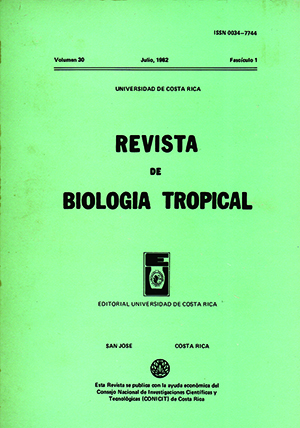Abstract
The house sparrow (Passer domesticus) invaded Costa Rica in 1974 or early 1975 and is now established throughout the country in ecologically varied areas. Four plasma proteins: transferrin, ceruloplasmin, haptoglobin and albumin, and the blood groups of the ABO and Rh systems were studied in two populations from two ecologically different localities: Santa Cruz (54 m), Guanacaste Province and Cartago (1440 m), Cartago Province. Five different electrophoretic patterns were obtained for transferrin implying the presence of at least three segregating alleles in both populations. These were present in both localities, with pattern 1 predominating in Cartago (44%) and pattern 4 in Santa Cruz (35%). The other three (Hp, Alb, Cer) were monomorphic. Individuals belonging to the AB blood group (66%) and Rh- (85%) predominated in both localities. This genetic structure is probably determined by the migratory behavior, the colonization system of the species, the effective population size and random processes. Possible modes of adaptation of this group in Costa Rica are discussed.References
ush, F.M. 1967. Developmental and populational variation in ele ctrophoretic properties of dehydrogenascs, hydrolases and other blood proteins of the house sparrow. Palser domesticus. Comp. Biochem. Physiol., 22: 273-287.
Bush, F.M., J.R. Price & J.I. Townsend. 1970. Plasma esterases, their definitions and status as isozymes in the house sparrow. lnt. J. Biochem., 1: 85-107.
Costa Rica. Dirección General de Estadística y Censos. 1979. Población de la República de Costa Rica por Provincias, Cantones y Distritos. Estimación al 1 de julio de 1979. No 44. Ministerio de Economía, Industria y Comercio. San José, Costa Rica.
Ferrell, G.T. 1966. Variation in blood group frequencies in populations of song sparrows of the San Francisco Bay Region. Evolution, 20: 369-382.
Fudenberg, H.G., J.R.L. Pink, An-Chuan Wang, & S.D. Douglas. 1978. Basic lmmunogenetics. 2d ed. Oxford University Press, New York. 262 p.
Johnston, R.F. & W.J. Klitz. 1977. Variation and evolution in a granivorous bird: the house sparrow. p. 15-51. In Granivorous Birds in Ecosystems. International Biological Programme. Vol. 12. Cambridge University Press.
Johnston, R.F, & R.K. Selander. 1973. Evolution in the house sparrow III. Variation in size and sexual dimorphism in Europe, North and South America. Amer. Nat., 107: 373-390.
Klitz, W.J. 1972. Genetic consequences of colonization: The house sparrow in North America. Ph.D. Dissertation. University of Kansas. Lawrence, Kansas. 37 p.
Klitz, W.J. 1973. Empirical population genetics of the North American house sparrow. Ornith. Monogtaphs, 14: 34-37.
Manwell, E.C., & C.M. Ann 8aker. 1975. Molecular Genetics of Avian Proteins. VIII. Protein polymorphism in three species of Australian passerincs. Part XII. Comp. Biochem. Physiol., 508: 471477.
Maurer, H.R., & R.C. Allen. 1972. Userul buffer and gel systems for polyacrylamide gel electrophoresis. Z. Klin. Olem. u. KIin. Biochcm., 10: 220-225.
Nevo, E. 1978. Genctic variation in natural populations: Patterns and theory. Theoret. Pop. Biol., 13: 121-177.
Reynolds, J., & F. G. Stiles. 1982. Distribución y densidad de poblaciones del gorrión común (Passer domesticus; Aves: Ploceidae) en Costa Rica. Rev. Biol. Trop., 30: 65-71.
Robbins, C.S. 1973. lntroduction, spread and present abundance of the house sparrow in North America. Ornith. Monographs, 14: 3-9.
Sibley, C.G., & F.A. Johnsgard, 1959. Variability in the electrophoretic patterns of avian serum proteins. Condor, 61: 85-95.
Sibley. C.G., & H.T. Hendrickson. 1970. A comparative electrophoretical study of avian plasma proteins. Condor. 72: 43-49.
Smith. N.J.H. 1980. Further advances of house sparrows into the Brazilian Amazon. Condol, 82: 109-111.
##plugins.facebook.comentarios##

This work is licensed under a Creative Commons Attribution 4.0 International License.
Copyright (c) 1982 Revista de Biología Tropical


